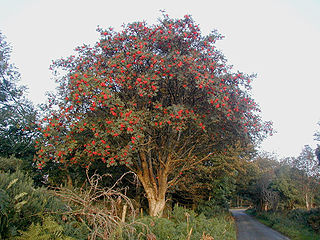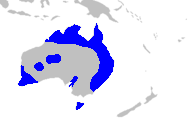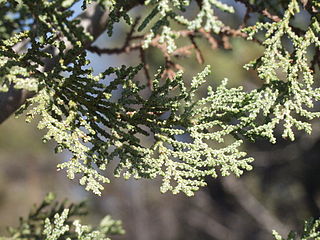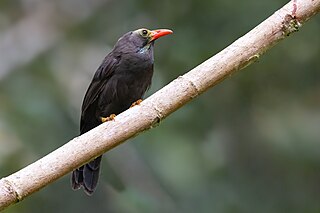
Acer rubrum, the red maple, also known as swamp maple, water maple, or soft maple, is one of the most common and widespread deciduous trees of eastern and central North America. The U.S. Forest Service recognizes it as the most abundant native tree in eastern North America. The red maple ranges from southeastern Manitoba around the Lake of the Woods on the border with Ontario and Minnesota, east to Newfoundland, south to Florida, and southwest to East Texas. Many of its features, especially its leaves, are quite variable in form. At maturity, it often attains a height around 30 m (100 ft). Its flowers, petioles, twigs, and seeds are all red to varying degrees. Among these features, however, it is best known for its brilliant deep scarlet foliage in autumn.

Quercus suber, commonly called the cork oak, is a medium-sized, evergreen oak tree in the section Quercus sect. Cerris. It is the primary source of cork for wine bottle stoppers and other uses, such as cork flooring and as the cores of cricket balls. It is native to southwest Europe and northwest Africa. In the Mediterranean basin the tree is an ancient species with fossil remnants dating back to the Tertiary period. It can survive for as long as two centuries. Typically, once it reaches 25 years old, its thick bark can be harvested for cork every 9 to 12 years without causing harm to the tree.

Sorbus aucuparia, commonly called rowan and mountain-ash, is a species of deciduous tree or shrub in the rose family. It is a highly variable species, and botanists have used different definitions of the species to include or exclude trees native to certain areas. A recent definition includes trees native to most of Europe and parts of Asia, as well as northern Africa. The range extends from Madeira, the British Isles and Iceland to Russia and northern China. Unlike many plants with similar distributions, it is not native to Japan.

Quercus virginiana, also known as the southern live oak, is an evergreen oak tree endemic to the Southeastern United States. Though many other species are loosely called live oak, the southern live oak is particularly iconic of the Old South. Many very large and old specimens of live oak can be found today in the Deep South region of the United States.

Magnolia grandiflora, commonly known as the southern magnolia or bull bay, is a tree of the family Magnoliaceae native to the Southeastern United States, from Virginia to central Florida, and west to East Texas. Reaching 27.5 m (90 ft) in height, it is a large, striking evergreen tree, with large, dark-green leaves up to 20 cm long and 12 cm wide, and large, white, fragrant flowers up to 30 cm (12 in) in diameter.

Quercus agrifolia, the California live oak, or coast live oak, is an evergreen live oak native to the California Floristic Province. Live oaks are so-called because they keep living leaves on the tree all year, adding young leaves and shedding dead leaves simultaneously rather than dropping dead leaves en masse in the autumn like a true deciduous tree. Coast live oaks may be shrubby, depending on age and growing location, but is generally a medium-sized tree. It grows west of the Sierra Nevada mountain range from Mendocino County, California, south to northern Baja California in Mexico. It is classified in the red oak section of oaks.

Enterolobium cyclocarpum, commonly known as conacaste, guanacaste, caro caro, devil's ear tree, monkey-ear tree, or elephant-ear tree, is a species of flowering tree in the family Fabaceae, that is native to tropical regions of the Americas, from central Mexico south to northern Brazil (Roraima) and Venezuela. It is known for its large proportions, expansive, often spherical crown, and curiously shaped seedpods. The abundance of this tree, especially in Guanacaste Province, Costa Rica, where it is prized for the shady relief it provides from the intense sun, coupled with its immensity, have made it a widely recognized species. It is the national tree of Costa Rica.

Xanthorrhoea is a genus of about 30 species of succulent flowering plants in the family Asphodelaceae. They are endemic to Australia. Common names for the plants include grasstree, grass gum-tree, kangaroo tail, balga, yakka, yamina (Tasmania), and black boy. The most common species is Xanthorrhoea australis, and some of these names are applied specifically to this species.

In horticulture, the term is used to differentiate a plant from shorter-lived annuals and biennials. It has thus been defined as a plant that lives more than two years. The term is also loosely used to distinguish plants with little or no woody growth from trees and shrubs, which are also technically perennials. Notably, it is estimated that 94% of plant species fall under the category of perennials, underscoring the prevalence of plants with lifespans exceeding two years in the botanical world.

Betula papyrifera is a short-lived species of birch native to northern North America. Paper birch is named after the tree's thin white bark, which often peels in paper-like layers from the trunk. Paper birch is often one of the first species to colonize a burned area within the northern latitudes, and is an important species for moose browsing. Primary commercial uses for paper birch wood are as boltwood and sawlogs, while secondary products include firewood and pulpwood. It is the provincial tree of Saskatchewan and the state tree of New Hampshire.

Hesperocyparis pygmaea, the Mendocino cypress or pygmy cypress, is a taxon of disputed status in the western cypress genus. It is endemic to certain coastal terraces and coastal mountain ranges of Mendocino and Sonoma Counties in northwestern California. It is a variable tree, and closely related to Hesperocyparis abramsiana and Hesperocyparis goveniana, enough to sometimes be considered conspecific with them.

Borassus is a genus of five species of fan palms, native to tropical regions of Africa, Asia, and Papua New Guinea.

Populus trichocarpa, the black cottonwood, western balsam-poplar or California poplar, is a deciduous broadleaf tree species native to western North America. It is used for timber, and is notable as a model organism in plant biology.

Hesperocyparis macnabiana is a species of western cypress in from California that was previously named Cupressus macnabiana.
The elm cultivar Ulmus 'Globosa' was first described in the Späth nursery catalogue of 1892–93. Considered "probably Ulmus carpinifolia " by Green

Ulmus 'Fiorente' is a hybrid cultivar elm derived from a crossing of the Siberian Elm Ulmus pumila clone 'S.10' from Lucca, Italy, with the Ulmus minor clone 'C.02' from Lungarno, Florence, by the Istituto per la Protezione delle Piante (IPP), part of the Italian National Research Council, in Florence. The tree is protected by Plant Breeders' Rights bestowed by the EU on 25 March 2010.

The white-crowned hornbill, also known as the long-crested hornbill or white-crested hornbill, is a species of hornbill.

The bare-headed laughingthrush is a species of bird in the Old World babbler family Timaliidae. It is endemic to highland forests at elevations of 750–1,800 m (2,460–5,910 ft) in the mountain ranges of north-central Borneo, along with some outlying peaks. It is 25–26 cm (9.8–10.2 in) long, with both sexes similar in appearance. The head is brownish to greenish yellow and featherless. The area along the lower mandible has a bluish tinge. The rest of the body is dull blackish-brown tinged with grey. Juveniles have more feathers on the head, extending from the forehead to the crown.

In botany, a tree is a perennial plant with an elongated stem, or trunk, usually supporting branches and leaves. In some usages, the definition of a tree may be narrower, including only woody plants with secondary growth, plants that are usable as lumber or plants above a specified height. In wider definitions, the taller palms, tree ferns, bananas, and bamboos are also trees.

Congregation Leaving the Reformed Church at Nuenen is an early painting by Vincent van Gogh, made in early 1884 and modified in late 1885. It is displayed at the Van Gogh Museum in Amsterdam.

















